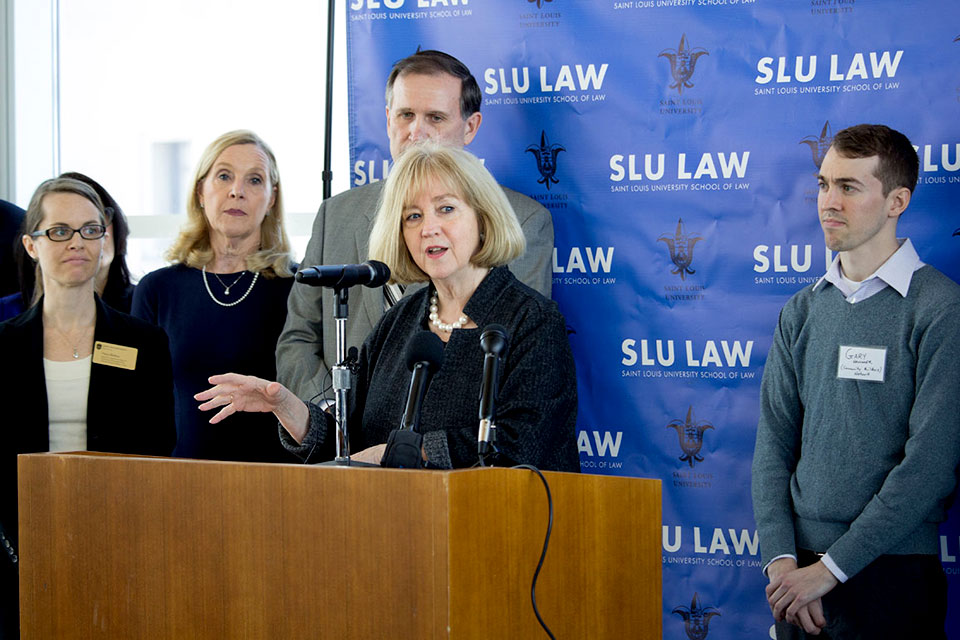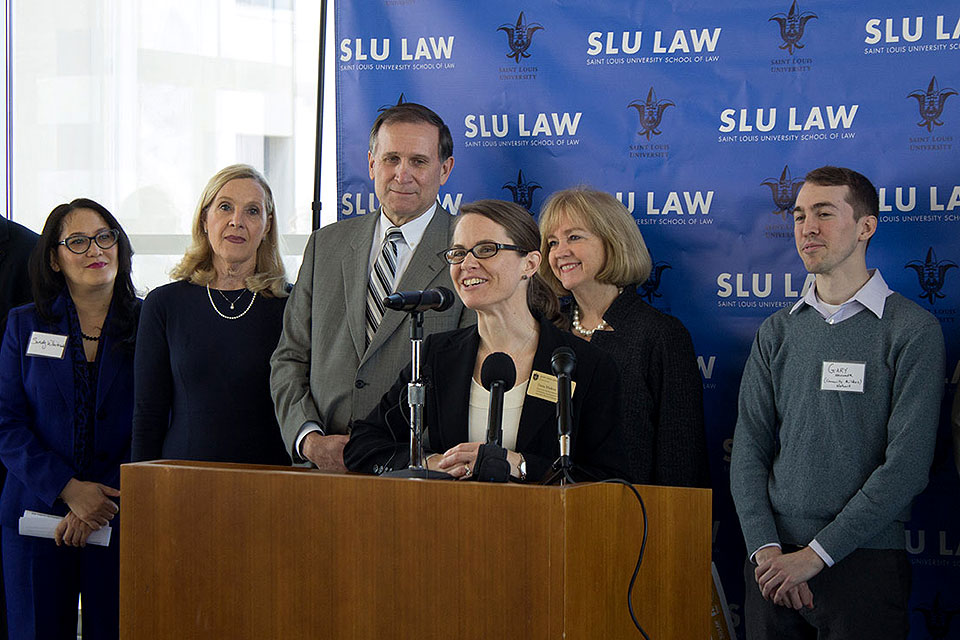School of Law Legal Clinics Lead Coalition to Address St. Louis’ Vacant Property Problems
04/19/2018
With approximately 25,000 vacant properties in the city, there is no question that St. Louis has a serious vacancy challenge. Vacancy leads to neighborhood decline by decreasing property values, discouraging investment, reducing available tax revenues and decreasing the quality of life for residents.
It is a challenge that School of Law Associate Dean of Experiential Education Dana Malkus, J.D., (Law ’04), is mobilizing to address. Malkus was joined by Mayor Lyda Krewson and nearly a dozen nonprofit and community organizations to announce a coalition that is working on concrete solutions that will move the region forward.
“Vacancy is an issue that certainly has negatively impacted our city for many years, some would even say probably decades, so I'm glad that we're all working together on it,” Krewson said. “So many people have come together on this, and that is the reason I think we’ll make some good progress here.”
The coalition working on these issues include the City of St. Louis, the Bar Association of Metropolitan St. Louis (BAMSL), Community Builders Network of Metro St. Louis (CBN), Legal Services of Eastern Missouri (LSEM), Rise Community Development, Saint Louis University School of Law (SLU LAW), St. Louis Association of Community Organizations (SLACO), St. Louis Development Corporation (SLDC), Tower Grove Neighborhoods Community Development Corporation (TGNCDC) and Green City Coalition (GCC), among others.
“Our partnership with the groups represented in the coalition is a natural extension of our mission to maintain and improve the quality of life for all persons,” said Malkus, who is also an associate professor and supervisor in the Entrepreneurship and Community Development Clinic. “Significant work has already been done to lay the groundwork in addressing the vacancy challenge, and we are proud of our students in the ECD clinic who have been involved with vacancy efforts since 2016.”
A significant amount of student research contributed to the development of a resource guide for community stakeholders. Thanks to a Regional Neighborhood Support Collaborative grant from Rise Community Development, TGNCDC and SLU LAW were able to develop this “plain-language” resource. “A Guide to Understanding and Addressing Vacant Property in the City of St. Louis” is now available to the public at risestl.org/vacancy-guide.

“We developed the guide to enable neighborhood leaders, local government agencies and other stakeholders to work together to address the vacancy challenge in our City,” Malkus said. “These issues are often so complex that stakeholders are unsure of where to get started. This guide will help remove those roadblocks.”
In addition to the resource guide, the coalition has been instrumental in the creation of LSEM’s new Neighborhood Vacancy Initiative. Support from the Mayor’s office, SLDC and BAMSL, in addition to funding from the Missouri IOLTA fund helped create the initiative. The Neighborhood Vacancy Initiative will expand LSEM’s outreach to neighborhoods to reduce poverty through neighborhood stabilization and equitable community-driven development, which will be led by a grant-funded staff attorney position.
The coalition plans to work with local government agencies and other community partners to align vacancy strategies and work collectively to reduce the negative impact of vacant property in St. Louis.
Following the press conference, SLU LAW and the coalition hosted a “Tools and Resources Workshop” in order for participants to get a first look at the resource guide and explore opportunities for further collaboration.
Saint Louis University School of Law was founded in 1843 and is the oldest law school west of the Mississippi River. The strength of the faculty, breadth of course offerings and extensive clinical and professional skills experience provide students with a well-rounded legal education. The School of Law’s rich history consists of strong connections to the community and a long tradition of public service. SLU LAW’s location in the heart of the City of St. Louis offers students unparalleled access to leading law firms, corporations, government agencies and nonprofit organizations — and a unique opportunity to see the law in action.
